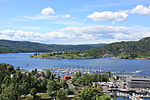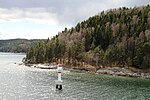Oscarsborg Fortress
1848 establishments in Norway2002 disestablishments in NorwayForts in NorwayFrognMilitary and war museums in Norway ... and 7 more
Military history of Norway during World War IIMilitary installations closed in 2002Military installations established in 1848Military installations in VikenMuseums in VikenProtected areas of NorwayWorld War II sites in Norway

Oscarsborg Fortress (Norwegian: Oscarsborg festning) is a coastal fortress in the Oslofjord, close to the small town of Drøbak in Viken County, Norway. The best known part is situated on two small islets. The main artillery batteries are on the island Håøya and smaller batteries on the mainland to the west and east in the Fjord and was military territory until 2003 when it was made a publicly available resort island. The fortress is best known for sinking the German heavy cruiser Blücher on 9 April 1940. In 2014, Oscarsborg Fortress was given protected status.
Excerpt from the Wikipedia article Oscarsborg Fortress (License: CC BY-SA 3.0, Authors, Images).Oscarsborg Fortress
Heredia,
Geographical coordinates (GPS) Address Nearby Places Show on map
Geographical coordinates (GPS)
| Latitude | Longitude |
|---|---|
| N 59.673611111111 ° | E 10.606666666667 ° |
Address
Heredia
Heredia
1723 , Agustín Ferrari
Buenos Aires, Argentina
Open on Google Maps








